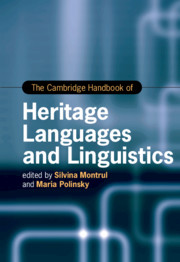Book contents
- The Cambridge Handbook of Heritage Languages and Linguistics
- Cambridge Handbooks In Language And Linguistics
- The Cambridge Handbook of Heritage Languages and Linguistics
- Copyright page
- Dedication
- Contents
- Figures and Tables
- Contributors
- Acknowledgments
- Introduction
- Part I Heritage Languages around the World
- Part II Research Approaches to Heritage Languages
- Part III Grammatical Aspects of Heritage Languages
- Part IV Heritage Language Education
- 29 Elementary School Heritage Language Educational Options and Outcomes
- 30 Community-Organized Heritage Language Programs
- 31 Curricular and Programmatic Language Development Opportunities for University-Level Heritage Language Learners
- 32 Instructed Heritage Language Acquisition
- 33 Issues and Practices in Community-Based Experiential Learning for Heritage Speakers in the United States
- 34 Developing Spanish Heritage Language Biliteracy
- 35 Heritage Language Assessment
- 36 Embracing Opportunity in Heritage Language Revitalization
- 37 Heritage Language Planning and Policy
- Index
- References
36 - Embracing Opportunity in Heritage Language Revitalization
from Part IV - Heritage Language Education
Published online by Cambridge University Press: 04 November 2021
- The Cambridge Handbook of Heritage Languages and Linguistics
- Cambridge Handbooks In Language And Linguistics
- The Cambridge Handbook of Heritage Languages and Linguistics
- Copyright page
- Dedication
- Contents
- Figures and Tables
- Contributors
- Acknowledgments
- Introduction
- Part I Heritage Languages around the World
- Part II Research Approaches to Heritage Languages
- Part III Grammatical Aspects of Heritage Languages
- Part IV Heritage Language Education
- 29 Elementary School Heritage Language Educational Options and Outcomes
- 30 Community-Organized Heritage Language Programs
- 31 Curricular and Programmatic Language Development Opportunities for University-Level Heritage Language Learners
- 32 Instructed Heritage Language Acquisition
- 33 Issues and Practices in Community-Based Experiential Learning for Heritage Speakers in the United States
- 34 Developing Spanish Heritage Language Biliteracy
- 35 Heritage Language Assessment
- 36 Embracing Opportunity in Heritage Language Revitalization
- 37 Heritage Language Planning and Policy
- Index
- References
Summary
While some heritage languages enjoy large numbers of speakers and vibrant communities, centuries-old and ongoing sociohistorical and sociolinguistic oppression has resulted in the extreme endangerment of many Indigenous languages. To counter this linguistic and cultural loss, a growing number of communities have engaged in language revitalization efforts that are tied to broader objectives of ethnic reclamation and cultural resistance, aiming not only to maintain but also to strengthen what has been lost. Heritage language revitalization is a long-term project that demands change and engagement across many aspects of community life, work that is ripe with tensions and contradictions. This chapter considers three recurrent questions in heritage language revitalization: what efforts should be prioritized in language revitalization, who should take responsibility in revitalizing a language, and how should revitalization efforts navigate the perceived need to establish linguistic norms and standards while concomitantly supporting linguistic diversity. To date, these questions have been described as tensions or problems that reveal conflicting priorities, often the result of historical inequalities, and that frequently hinder language revitalization efforts. Rather than framing these questions as problems, the present chapter considers how communities have responded to these challenges to create new opportunities for collaboration and new approaches that embrace ambiguity and pluralism.
Keywords
- Type
- Chapter
- Information
- The Cambridge Handbook of Heritage Languages and Linguistics , pp. 912 - 933Publisher: Cambridge University PressPrint publication year: 2021



